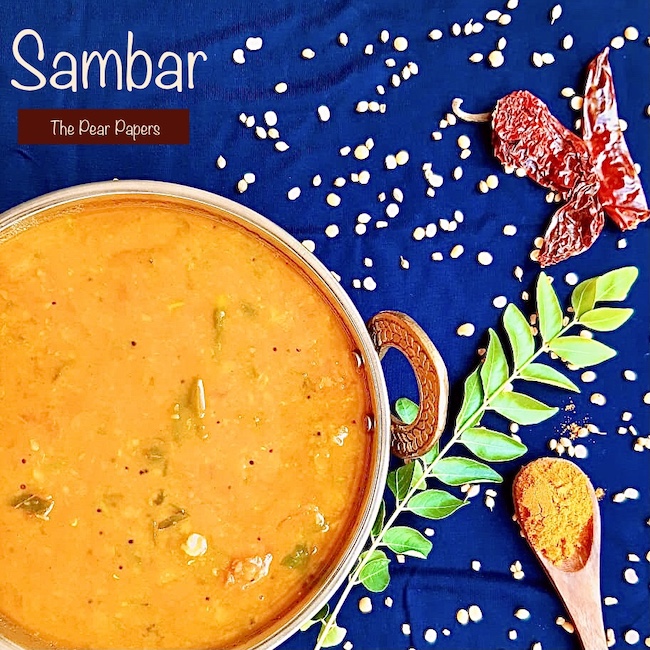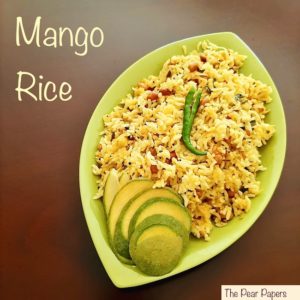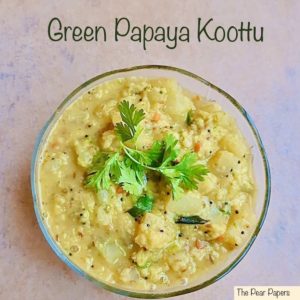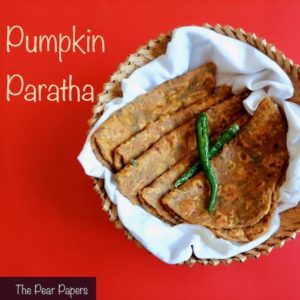
Sambar
Sambar is a staple dish in many South Indian families. There are several Sambar recipes in different South Indian states, but the base ingredients like, lentils, tamarind-tomato broth and Sambar powder are pretty much constant.
There is no hard and fast rule as to what vegetables you can use. Having said that, there are some favourite varieties of sambar in my house like onion-drumstick, mixed vegetable, pumpkin-capsicum, fenugreek/drumstick leaves and shallots. These are some of the common, more flavourful varieties and a great combination for pretty much all South Indian tiffin items like dosai, idli, upma, veN pongal, pidi kozhukkattai and medhu vadai. You can mix sambar with plain rice (as a main course dish) and also have it as a side for curd rice.
There are two main methods to make Sambar. The first method is by roasting the Sambar masala/powder ingredients, adding fresh coconut to the ground masala, grinding it to make a paste and adding it towards the end of the preparation to give a fresh, strong flavour. The other version, which I’ve shown here, is relatively simpler and uses only homemade Sambar powder.
Sambar has a good balance of lentils and veggies so it’s not only delicious, but also incredibly nutritious!
Ingredients
Toor dhal – 1 cup (see note 1 for alternative)
Turmeric powder – 1 tsp
Ghee – 1 tsp (optional)
Sesame oil (cooking grade) – 2 1/2 tbsp
Asafoetida – 1 tsp
Mustard seeds – 1 tsp
Fenugreek seeds – 1 tbsp (see note 2)
Dry red chilly – 1 (or to taste)
Green Capsicum (cubed) – 1
Pumpkin cubes – 2 cups
Green chilly (slit) – 1 (or to taste)
Curry leaves – a few
Tamarind – 1 small lemon sized piece (see note 4 for alternatives)
Tomato (chopped into big chunks) – 1 large (or 2 medium)
Jaggery – 1 tablespoon
Sambar powder – 2 1/2 tsp
Salt – 1 1/4 tsp (or to taste)
Coriander leaves – to garnish (optional)
Water ~ 400 ml
Yield
Serves 5
Prep time
1/2 hr
Cook time
1/2 hr
Method
1) Wash the toor dhal once and boil it with turmeric powder, 1/4 tsp of asafoetida and ghee until soft (pressure cooker works best for this, but you could also just use a pot). Stir the boiling dhal frequently to stop it sticking to the bottom of the pot. The consistency of the cooked dhal should be like a thick porridge, and should be cooked thoroughly until mashable.
2) Simultaneously, boil the tamarind and tomatoes together in a pot until the skin of the tomatoes starts to shrink and peel off. Transfer to a wide pan and let it cool down a bit. Once it cools down, remove the skin of the tomatoes and discard. Mash the peeled tomatoes and tamarind. Discard any impurities from the tamarind at this stage. Set aside this tomato-tamarind pulp. (see note 4 for a quicker alternative)
3) Heat a wide pan to medium heat and add 2 tbsp sesame oil. Add mustard seeds and let it splutter. Now add the red chilly and fenugreek seeds, fry until fenugreek seeds turn light brown. Add 3/4 tsp of asafoetida and mix once. Immediately add the chopped pumpkin, capsicum, curry leaves and green chilly. Mix once. Cover the pan and cook for 3 to 4 mins or until the vegetables start to sweat.
4) Open the pan and mix once. Add the sambar powder and fry for just 30 seconds. Immediately add the tamarind-tomato pulp. Add salt, jaggery and water. Increase the heat and bring the sambar to a rolling boil and then bring it to medium heat and allow the sambar to boil for 8 to 10 mins.
5) After 10 mins the vegetables should be cooked and the raw smell of the sambar powder will be gone. Now reduce the heat completely and let it simmer for a further 5 mins or until the oil starts to float on top of the sambar.
6) Add the cooked dhal now and mix well. Keep the heat minimum. When you see small bubbles start to form on the surface and sides of the sambar, switch off the heat. Garnish with 1/2 tbsp sesame oil, chopped coriander and curry leaves.
Notes
- I’ve used toor dhal in this recipe. As an alternative, you can use a toor-masoor dhal mix as well. The soaking and cooking process remains the same.
- Instead of dry fenugreek seeds you can use sprouted fenugreek seeds. Sprouting actually reduces the mild bitterness of the fenugreek seeds and increases its nutritive value. (See Fenugreek grape pickle for tips on sprouting fenugreek)
- Add a small quantity of ghee to the dhal while cooking to stop it from overflowing, whether in an open pan or in a pressure cooker. It also enhances the flavour of the cooked dhal.
- Using only tamarind or only tomatoes will also work fine for making sambar. But a combination of both gives a nice balance of tang and sweetness, so I prefer to use both. If you don’t have fresh tamarind, you can use 2tsp tamarind paste instead and blend it with the boiled tomatoes.
Beginner’s tips
- Soak your dhal for a minimum of half an hour before boiling to reduce cooking time.


You May Also Like

Mango Rice
September 29, 2021
Green Papaya Koottu
December 4, 2021